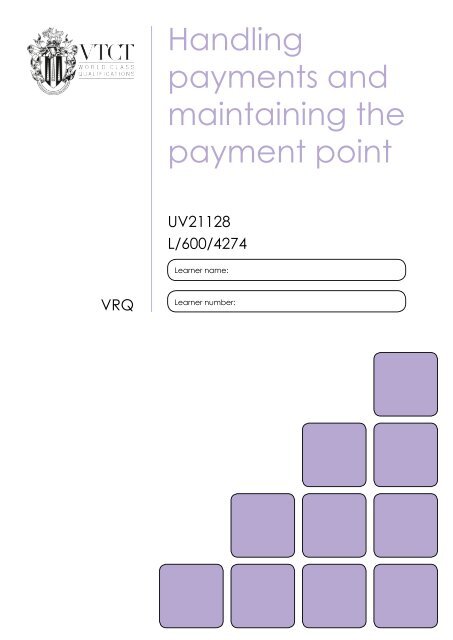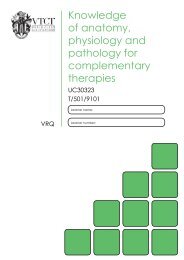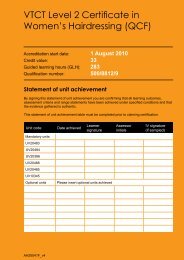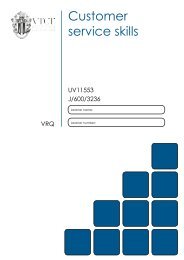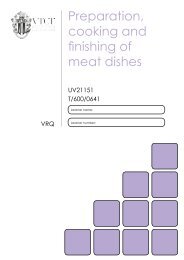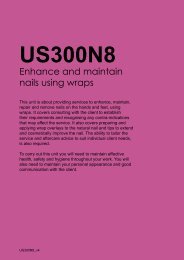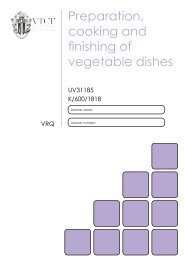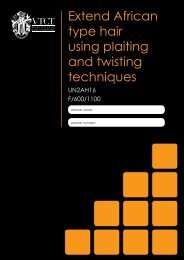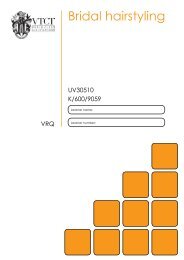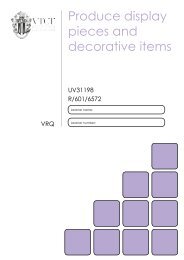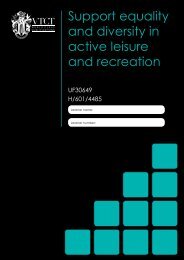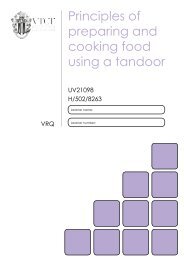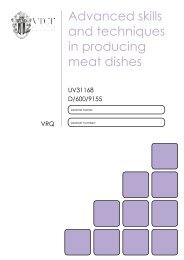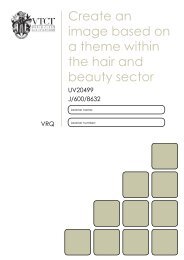Handling payments and maintaining the payment point - VTCT
Handling payments and maintaining the payment point - VTCT
Handling payments and maintaining the payment point - VTCT
You also want an ePaper? Increase the reach of your titles
YUMPU automatically turns print PDFs into web optimized ePapers that Google loves.
VRQ<br />
<strong>H<strong>and</strong>ling</strong><br />
<strong><strong>payment</strong>s</strong> <strong>and</strong><br />
<strong>maintaining</strong> <strong>the</strong><br />
<strong>payment</strong> <strong>point</strong><br />
UV21128<br />
L/600/4274<br />
Learner name:<br />
Learner number:
Statement of unit achievement<br />
By signing this statement of unit achievement you are confirming that all learning outcomes, assessment<br />
criteria <strong>and</strong> range statements have been achieved under specified conditions <strong>and</strong> that <strong>the</strong> evidence<br />
ga<strong>the</strong>red is au<strong>the</strong>ntic.<br />
This statement of unit achievement table must be completed prior to claiming certification.<br />
Unit code Date achieved Learner signature<br />
Assessor tracking table<br />
<strong>VTCT</strong> is <strong>the</strong> specialist awarding body for <strong>the</strong> Hairdressing, Beauty Therapy, Complementary Therapy,<br />
Hospitality <strong>and</strong> Catering <strong>and</strong> Sport <strong>and</strong> Active Leisure sectors, with over 45 years of experience.<br />
<strong>VTCT</strong> is an awarding body regulated by national organisations including Ofqual, SQA, DfES <strong>and</strong> CCEA.<br />
<strong>VTCT</strong> is a registered charity investing in education <strong>and</strong> skills but also giving to good causes in <strong>the</strong> area<br />
of facial disfigurement.<br />
Assessor name Assessor signature<br />
Assessor<br />
initials<br />
Assessors<br />
initials<br />
IV signature<br />
(if sampled)<br />
All assessors using this Record of Assessment book must complete this table. This is required for<br />
verification purposes.<br />
Assessor number<br />
(optional)
UV21128<br />
<strong>H<strong>and</strong>ling</strong> <strong><strong>payment</strong>s</strong> <strong>and</strong><br />
<strong>maintaining</strong> <strong>the</strong> <strong>payment</strong> <strong>point</strong><br />
The aim of this unit is to develop your knowledge,<br />
underst<strong>and</strong>ing <strong>and</strong> practical skills in h<strong>and</strong>ling <strong><strong>payment</strong>s</strong><br />
<strong>and</strong> <strong>maintaining</strong> <strong>the</strong> <strong>payment</strong> <strong>point</strong>. You will learn how to<br />
open, maintain <strong>and</strong> close a <strong>payment</strong> <strong>point</strong>, how to deal<br />
with <strong><strong>payment</strong>s</strong>, <strong>and</strong> <strong>the</strong> importance of <strong>the</strong> cashier’s role in<br />
<strong>maintaining</strong> security.<br />
You will learn <strong>the</strong> security procedures involved in<br />
<strong>maintaining</strong> <strong>the</strong> <strong>payment</strong> <strong>point</strong> <strong>and</strong> <strong>the</strong> purpose of <strong>the</strong><br />
control systems used to process customer bills.<br />
UV21128_v5
Level<br />
Credit value<br />
GLH<br />
2<br />
3<br />
24<br />
Observation(s)<br />
2<br />
External paper(s)<br />
0
<strong>H<strong>and</strong>ling</strong> <strong><strong>payment</strong>s</strong> <strong>and</strong><br />
<strong>maintaining</strong> <strong>the</strong> <strong>payment</strong> <strong>point</strong><br />
Learning outcomes<br />
On completion of this unit you will:<br />
1. Be able to deal with <strong><strong>payment</strong>s</strong><br />
2. Be able to open, maintain <strong>and</strong> close a<br />
<strong>payment</strong> <strong>point</strong><br />
3. Underst<strong>and</strong> <strong>the</strong> security procedures at <strong>the</strong><br />
<strong>payment</strong> <strong>point</strong><br />
Evidence requirements<br />
1. Environment<br />
Evidence for this unit may be ga<strong>the</strong>red<br />
within <strong>the</strong> workplace or realistic working<br />
environment (RWE).<br />
2. Simulation<br />
Simulation may be used in this unit, where<br />
no naturally occurring evidence is available.<br />
3. Observation outcomes<br />
Competent performance of Observation<br />
outcomes must be demonstrated on<br />
at least two occasions. Assessor<br />
observations, witness testimonies <strong>and</strong><br />
products of work are likely to be <strong>the</strong> most<br />
appropriate sources of performance<br />
evidence. Professional discussion may be<br />
used as supplementary evidence for those<br />
criteria that do not naturally occur.<br />
Assessed observations should not be<br />
carried out on <strong>the</strong> same day for <strong>the</strong><br />
same learning outcome. There should be<br />
sufficient time between assessments for<br />
reflection <strong>and</strong> personal development.<br />
You need to meet <strong>the</strong> same st<strong>and</strong>ard on a<br />
regular <strong>and</strong> consistent basis. Separating<br />
<strong>the</strong> assessments by a period of at least two<br />
weeks is recommended as competence<br />
must be demonstrated on a consistent <strong>and</strong><br />
regular basis.<br />
4. Range<br />
All ranges must be practically demonstrated<br />
or o<strong>the</strong>r forms of evidence produced to<br />
show <strong>the</strong>y have been covered.<br />
5. Knowledge outcomes<br />
There must be evidence that you possess<br />
all <strong>the</strong> knowledge <strong>and</strong> underst<strong>and</strong>ing<br />
listed in <strong>the</strong> Knowledge section of this<br />
unit. In most cases this can be done<br />
by professional discussion <strong>and</strong>/or oral<br />
questioning. O<strong>the</strong>r methods, such as<br />
projects, assignments <strong>and</strong>/or reflective<br />
accounts may also be used.<br />
6. Tutor/Assessor guidance<br />
You will be guided by your tutor/assessor<br />
on how to achieve learning outcomes <strong>and</strong><br />
cover ranges in this unit. All outcomes <strong>and</strong><br />
ranges must be achieved.<br />
7. External paper<br />
There is no external paper requirement for<br />
this unit.<br />
UV21128<br />
3
4<br />
Achieving observations<br />
<strong>and</strong> range<br />
Achieving observation outcomes Achieving range<br />
Your assessor will observe your performance<br />
of practical tasks. The minimum number of<br />
competent observations required is indicated in<br />
<strong>the</strong> Evidence requirements section of this unit.<br />
Criteria may not always naturally occur during<br />
a practical observation. In such instances you<br />
will be asked questions to demonstrate your<br />
competence in this area. Your assessor will<br />
document <strong>the</strong> criteria that have been achieved<br />
through professional discussion <strong>and</strong>/or oral<br />
questioning. This evidence will be recorded<br />
by your assessor in written form or by o<strong>the</strong>r<br />
appropriate means.<br />
Your assessor will sign off a learning outcome<br />
when all criteria have been competently<br />
achieved.<br />
UV21128<br />
The range section indicates what must<br />
be covered. Ranges should be practically<br />
demonstrated as part of an observation. Where<br />
this is not possible o<strong>the</strong>r forms of evidence may<br />
be produced. All ranges must be covered.<br />
Your assessor will document <strong>the</strong> portfolio<br />
reference once a range has been competently<br />
achieved.
Learning outcome 1<br />
Be able to deal with <strong><strong>payment</strong>s</strong><br />
You can:<br />
a. Prepare <strong>and</strong> present customer bills<br />
b. Carry out <strong>payment</strong> transactions<br />
c. Balance <strong>payment</strong> received<br />
*May be assessed by supplementary evidence.<br />
Observations<br />
Observation 1 2 Optional Optional<br />
Criteria questioned orally<br />
Date achieved<br />
Portfolio reference<br />
Learner signature<br />
Assessor initials<br />
UV21128<br />
5
6<br />
Learning outcome 2<br />
Be able to open, maintain <strong>and</strong> close a <strong>payment</strong> <strong>point</strong><br />
You can:<br />
a. Prepare <strong>the</strong> <strong>payment</strong> <strong>point</strong> for service<br />
b. Maintain float <strong>and</strong> equipment<br />
c. Perform close-down procedure<br />
*May be assessed by supplementary evidence.<br />
Observation 1 2 Optional Optional<br />
Criteria questioned orally<br />
Date achieved<br />
Portfolio reference<br />
Learner signature<br />
Assessor initials<br />
UV21128
You must practically demonstrate that you have:<br />
Range<br />
Dealt with a minimum of 2 materials Portfolio reference<br />
Cash<br />
Cash equivalents<br />
Relevant stationery<br />
Till/credit/debit rolls<br />
Dealt with a minimum of 2 types of <strong><strong>payment</strong>s</strong> Portfolio reference<br />
Cash<br />
Cheques<br />
Credit cards<br />
Debit cards<br />
Cash equivalents<br />
Completed a minimum of 3 <strong>payment</strong> procedures Portfolio reference<br />
Take ‘z’ or ‘x’ reading<br />
Count float<br />
Count takings<br />
Check balance against till readings<br />
Completed record sheets<br />
Followed procedures for reporting discrepancies<br />
Secured takings<br />
It is strongly recommended that all range items are practically demonstrated. Where this is not<br />
possible, o<strong>the</strong>r forms of evidence may be produced to demonstrate competence.<br />
UV21128 7
8<br />
Developing knowledge<br />
Achieving knowledge outcomes<br />
You will be guided by your tutor <strong>and</strong> assessor<br />
on <strong>the</strong> evidence that needs to be produced.<br />
Your knowledge <strong>and</strong> underst<strong>and</strong>ing will be<br />
assessed using <strong>the</strong> assessment methods listed<br />
below*:<br />
• Projects<br />
• Observed work<br />
• Witness statements<br />
• Audio-visual media<br />
• Evidence of prior learning or attainment<br />
• Written questions<br />
• Oral questions<br />
• Assignments<br />
• Case studies<br />
• Professional discussion<br />
Where applicable your assessor will integrate<br />
knowledge outcomes into practical observations<br />
through professional discussion <strong>and</strong>/or oral<br />
questioning.<br />
When a criterion has been orally questioned<br />
<strong>and</strong> achieved, your assessor will record this<br />
evidence in written form or by o<strong>the</strong>r appropriate<br />
means. There is no need for you to produce<br />
additional evidence as this criterion has already<br />
been achieved.<br />
Some knowledge <strong>and</strong> underst<strong>and</strong>ing outcomes<br />
may require you to show that you know <strong>and</strong><br />
underst<strong>and</strong> how to do something. If you have<br />
practical evidence from your own work that<br />
meets knowledge criteria, <strong>the</strong>n <strong>the</strong>re is no<br />
requirement for you to be questioned again on<br />
<strong>the</strong> same topic.<br />
*This is not an exhaustive list.<br />
UV21128
Knowledge<br />
Learning outcome 1<br />
Be able to deal with <strong><strong>payment</strong>s</strong><br />
You can: Portfolio reference<br />
d. Explain <strong>the</strong> responsibilities in preparing a customer bill<br />
e. Identify types of problems that might occur when taking <strong><strong>payment</strong>s</strong><br />
f. Explain procedures for dealing with unexpected situations when<br />
processing <strong><strong>payment</strong>s</strong><br />
UV21128 9
10<br />
Learning outcome 2<br />
Be able to open, maintain <strong>and</strong> close a <strong>payment</strong> <strong>point</strong><br />
You can: Portfolio reference<br />
d. Describe <strong>the</strong> checks required to set up <strong>and</strong> close a <strong>payment</strong> <strong>point</strong><br />
e. Explain <strong>the</strong> purpose of a float<br />
UV21128
Learning outcome 3<br />
Underst<strong>and</strong> <strong>the</strong> security procedures at <strong>the</strong> <strong>payment</strong> <strong>point</strong><br />
You can: Portfolio reference<br />
a. Explain <strong>the</strong> role of a cash h<strong>and</strong>ler in <strong>maintaining</strong> <strong>the</strong> security of <strong>the</strong><br />
<strong>payment</strong> <strong>point</strong><br />
b. Explain <strong>the</strong> procedures for secure h<strong>and</strong>ling of <strong><strong>payment</strong>s</strong><br />
c. Explain <strong>the</strong> purpose of <strong>the</strong> control systems used to process<br />
customer bills<br />
UV21128 11
12<br />
Unit content<br />
This section provides guidance on <strong>the</strong> recommended knowledge <strong>and</strong> skills required to enable you<br />
to achieve each of <strong>the</strong> learning outcomes in this unit. Your tutor/assessor will ensure you have <strong>the</strong><br />
opportunity to cover all of <strong>the</strong> unit content.<br />
Outcome 1: Be able to deal with <strong><strong>payment</strong>s</strong><br />
Prepare customer bills: Use <strong>payment</strong><br />
<strong>point</strong> (electronic, manual), ensure<br />
sufficient stationery (till roll, bills, stapler,<br />
pens), knowledge of prices (price lists,<br />
menus, pre-programmed till, dockets,<br />
VAT receipts), post charges (accurately,<br />
promptly, to <strong>the</strong> correct revenue<br />
department), sub-total <strong>and</strong> total as<br />
necessary, check before printing.<br />
Present customer bills: Ask <strong>the</strong>m to<br />
check bill, uphold customer service<br />
st<strong>and</strong>ards, follow company procedure,<br />
process <strong>payment</strong> efficiently, file dockets<br />
with bill.<br />
Carry out <strong>payment</strong> transactions: Accept<br />
<strong>payment</strong> following company procedure,<br />
tell <strong>the</strong> customer how much <strong>the</strong>y have to<br />
pay, cash (check amount tendered, count<br />
change back to customer, secure cash),<br />
cheques (print or ask customer to fill out<br />
cheque, obtain customer signature, check<br />
signature, valid to <strong>and</strong> from dates, card<br />
number <strong>and</strong> payee details, ensure amount<br />
is within card guarantee limits), credit <strong>and</strong><br />
debit cards (entering into card machine,<br />
following instructions, card processing<br />
protocols), cash equivalents (follow<br />
organisation’s procedures), acknowledge<br />
<strong>the</strong> customer’s <strong>payment</strong>, give <strong>the</strong> correct<br />
change <strong>and</strong> issue receipt when required<br />
by <strong>the</strong> customer, put <strong>the</strong> <strong>payment</strong> in <strong>the</strong><br />
right place according to <strong>the</strong> organisation’s<br />
procedures, comply with legislation, uphold<br />
customer service st<strong>and</strong>ards, follow cash<br />
<strong>point</strong> security procedures at all times.<br />
Balance <strong>payment</strong> received: Take ‘z’ or<br />
‘x’ reading as appropriate, count float,<br />
UV21128<br />
count takings, check balance against till<br />
readings, completing record sheets, follow<br />
procedures for reporting discrepancies,<br />
deal with takings as appropriate (place in<br />
safe, ask for it to be collected).<br />
Responsibilities in preparing a<br />
customer bill: Follow organisation’s<br />
procedures (customer satisfaction, efficient<br />
service, reducing errors <strong>and</strong> <strong>the</strong>ft, ensure<br />
charges are posted to <strong>the</strong> correct revenue<br />
department), post charges promptly <strong>and</strong><br />
accurately, report discrepancies <strong>and</strong><br />
errors immediately, keep <strong>the</strong> <strong>payment</strong> area<br />
secure (ensuring <strong>payment</strong> <strong>point</strong> is not left<br />
unattended, restricting access), follow<br />
procedures for declining <strong>payment</strong>, prompt<br />
<strong>and</strong> polite response to customer request for<br />
bill, advise customer of any delays, receive<br />
<strong>payment</strong> <strong>and</strong> give change as required,<br />
putting <strong>the</strong> <strong>payment</strong> in <strong>the</strong> right place,<br />
follow cash <strong>point</strong> security procedures at all<br />
times.<br />
Problems that might occur when taking<br />
<strong><strong>payment</strong>s</strong>: Equipment breakdown, card<br />
declined, insufficient notes or change,<br />
delays (queues, customer forgets pin, card<br />
will not swipe), customer unable to make<br />
<strong>payment</strong>, incorrect customer bill, attempted<br />
fraud or <strong>the</strong>ft.<br />
Procedures for dealing with unexpected<br />
situations: System or power failure<br />
(manual processing of transactions, report<br />
breakdown), emergency evacuation of<br />
premises (securing monies, logging out<br />
of till system, printing any necessary<br />
reports), suspicious use of card, runner,<br />
opportunist <strong>the</strong>ft or customer unable to pay
Outcome 1: Be able to deal with <strong><strong>payment</strong>s</strong> (continued)<br />
(follow organisation’s procedure, acting<br />
promptly), PDQ breakdown (switch to<br />
manual/telephone processing), suspected<br />
counterfeit notes (make checks <strong>and</strong> follow<br />
establishment procedures).<br />
Outcome 2: Be able to open, maintain <strong>and</strong> close a <strong>payment</strong> <strong>point</strong><br />
Prepare <strong>the</strong> <strong>payment</strong> <strong>point</strong>: Make<br />
sure <strong>the</strong> equipment is switched on<br />
<strong>and</strong> in working order, log on/sign in<br />
to <strong>the</strong> till <strong>and</strong> PDQ machine following<br />
company procedure, ensure <strong>the</strong>re are<br />
sufficient materials (till roll, VAT receipts,<br />
customer bills, pen, stapler, bill wallets),<br />
ensure sufficient change, count float,<br />
complete relevant paperwork, report any<br />
discrepancies.<br />
Maintain float <strong>and</strong> equipment: Promptly<br />
identify <strong>and</strong> report low levels of change,<br />
follow cash <strong>point</strong> security procedures at all<br />
times, maintain agreed levels of stationery,<br />
identify <strong>and</strong> resolve discrepancies with<br />
float within limits of own authority, report<br />
overs <strong>and</strong> shortages as soon as <strong>the</strong>y are<br />
detected, follow organisation’s procedures.<br />
Perform close-down procedure: Take ‘z’<br />
or ‘x’ readings as appropriate, count float,<br />
count takings, check balance against till<br />
readings, complete record sheets, follow<br />
procedures for reporting discrepancies,<br />
deal with takings as appropriate (place in<br />
safe, ask for it to be collected).<br />
Checks required to set up <strong>and</strong> close a<br />
<strong>payment</strong> <strong>point</strong>: Agree/accept/sign float,<br />
check sufficient additional materials (pens,<br />
till rolls, receipts), balance takings against<br />
till reading, h<strong>and</strong>over float.<br />
Purpose of a float: Allow trading at start of<br />
day prior to sales, provide change for items<br />
sold, prevent delays at <strong>the</strong> <strong>payment</strong> <strong>point</strong>,<br />
allow uplifts without reducing amount of<br />
change available.<br />
UV21128 13
14<br />
Outcome 3: Underst<strong>and</strong> <strong>the</strong> security procedures at <strong>the</strong> <strong>payment</strong> <strong>point</strong><br />
Role of a cash h<strong>and</strong>ler in <strong>maintaining</strong><br />
<strong>the</strong> security of <strong>the</strong> <strong>payment</strong> <strong>point</strong>:<br />
Follow organisation’s procedures for<br />
accepting <strong><strong>payment</strong>s</strong> to reduce risk of fraud<br />
or mistakes, ensure bills are up to date,<br />
available for <strong>the</strong> customer <strong>and</strong> accurate,<br />
secure monies <strong>and</strong> documentation, secure<br />
<strong>payment</strong> <strong>point</strong> from unauthorised access,<br />
carrying out balancing procedures.<br />
Procedures for secure h<strong>and</strong>ling of<br />
<strong><strong>payment</strong>s</strong>: Cash (check amount tendered,<br />
count change back to customer, secure<br />
cash), cheques (print or ask customer to<br />
fill out cheque, obtain customer signature,<br />
check signature, valid to <strong>and</strong> from dates,<br />
card number <strong>and</strong> payee details, ensure<br />
amount is within card guarantee limits),<br />
credit <strong>and</strong> debit cards (entering into card<br />
machine, following instructions, card<br />
processing protocols), cash equivalents<br />
(follow organisation’s procedures), deal<br />
with mistakes/refunds/voids, use of PDQ<br />
machines, report anything unusual or<br />
suspicious.<br />
Purpose of <strong>the</strong> control systems used<br />
to process customer bills: Security of<br />
<strong>payment</strong>, minimising risks of fraud/<strong>the</strong>ft/<br />
mistakes, to support stock control, to assist<br />
accuracy of sales data <strong>and</strong> management<br />
reports, accuracy of bills, customer<br />
satisfaction.<br />
UV21128


